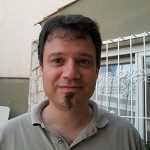ARSEA - Augmented Reality Subsea Exploration Assistant
Thanks to recent technological advances, remote and complex underwater scenarios are more accessible for scientific and industrial activities, such as surveying, sampling, rescue or industrial infrastructure inspection and maintenance. Commercial ROVs are endowed with one or several cameras providing an online view of their surroundings to a human operator who is in charge of remotely piloting them.
The reduced field of view and the difficulty to remotely maneuver a 6DOF vehicle with complex dynamics make the ROV piloting a difficult and error prone task requiring trained operators. Our proposal is aimed at solving these problems by providing an advanced, practical and comfortable user interface with three main goals: 1) To build an online, accurate, 3D reconstruction of the robot and all of the explored surroundings, providing an immersive 1st and 3rd person view of the whole explored environment. In subsequent versions, the pilot will be able to select interest areas which will be enlarged and/or revisited if necessary, to be shown with more detail and better resolution. 2) To allow the human operator to command the robot and select goal points in the reconstruction, switching between autonomous and manual control. 3) To fuse online and previously gathered data to establish temporal correlations and observe long-term changes in the sub-sea such as the grow ratio of underwater flora or the degradation of submerged structures. As a result of this work, underwater inspection tasks would significantly change. On the one hand, the remote operation is facilitated, showing in a virtual reality environment the whole explored area, making it less error prone and allowing non trained operators to drive ROVs focusing their effort on decision taking and fine maneuver. On the other hand, the ROV operating range is increased in space, depth and time when compared to tasks currently performed either by ROVs or human divers. Our proposal could be applied to scientific tasks, such as the study of the growth ratio of underwater flora, usually performed by divers who have limited immersion times, increasing the accuracy of the collected data. Also, it could be applied to industrial tasks, such as evaluating the degradation of underwater structures as well as pipe and power and communication cable inspection.
Project Leader
Project Collaborators
-

Yolanda González Cid
-
Photo
Dietrich Paulus
-
Photo
Jose Luís Lisani
-
Photo
Ana Belén Petro
-

Francisco Bonin-Font
-

Miquel Massot Campos
Fellow Researcher at University of Southampton
Related Publications
-
Sparse Gaussian Process for Online Seagrass Semantic Mapping
Expert Systems with Applications
-
A deep learning solution for Posidonia oceanica seafloor habitat multiclass recognition
IEEE Oceans
-
A Trajectory-Based Approach to Multi-Session Underwater Visual SLAM Using Global Image Signatures
Journal of Marine Science and Engineering
-
Real-time Hash-based Loop Closure Detection in Underwater Multi-Session Visual SLAM
IEEE Oceans
-
Design and control of an Autonomous Surface Vehicle to improve Link Communications
Design and control of an Autonomous Surface Vehicle to improve Link Communications
-
Underwater Localization using Probabilistic Sonar Registration and Pose Graph Optimization
IEEE OES Autonomous Underwater Vehicle Symposium
-
Deep Semantic Segmentation in an AUV for Online Posidonia Oceanica Meadows Identification
IEEE Access
-
Towards Multi Session Visual SLAM in Underwater Environments Colonized with Posidonia Oceanica
IEEE OES Autonomous Underwater Vehicle Symposium
-
Evaluating the Impact of Sewage Discharges on the Marine Environment with a Lightweight AUV
Marine Pollution Bulletin
-
ARSEA: A Virtual Reality Subsea Exploration Assistant
11th IFAC Conference on Control Applications in Marine Systems, Robotics, and Vehicles
-
Reconstrucción Visual 3D para el prediagnóstico de heridas post-operatorias
XV Reunión de Salut Conectada
-
Towards a Pre-diagnose of Surgical Wounds Through the Analysis of Visual 3D Reconstructions.
International Conference on Computer Vision Theory and Applications (VISSAP)
-
Visual Discrimination and Large Area Mapping of Posidonia Oceanica Using a Lightweight AUV
IEEE Access
-
Hacia la Navegación Visual de un Vehı́culo Autónomo Submarino en Areas con Posidonia Oceanica
Revista Iberoamericana de Automática e Informática Industrial
-
Indistinguishability Operators Applied to Task Allocation Problems in Multi-Agent Systems
Applied Sciences
-
A Novel Approach to Register Sonar Data for Underwater Robot Localization
IEEE IntelliSys
-
Building Large-Scale Coverage Maps of Posidonia Oceanica using an Autonomous Underwater Vehicle
MTS/IEEE Oceans
-
Towards a new Methodology to Evaluate the Environmental Impact of a Marine Outfall Using a Lightweight AUV
MTS/IEEE Oceans
-
USBL Integration and Assessment in a Multisensor Navigation Approach for AUVs
The 20th World Congress of the International Federation of Automatic Control (IFAC World Congress)
-
Machine Learning and Deep Learning Strategies to Identify Posidonia Meadows in Underwater Images
MTS/IEEE OCEANS17 Aberdeen
-
A 3D Mapping, Obstacle Avoidance and Acoustic Communication Payload for the AUV SPARUS II
7th International Workshop on Marine Technology (MARTECH)
-
An USBL-Aided Multisensor Navigation System for Field AUVs
IEEE International Conference on Multisensor Fusion and Integration for Intelligent Systems (MFI )
-
Towards Automatic Visual Sea Grass Detection in Underwater Areas of Ecological Interest
IEEE International Conference on Emerging Technologies and Factory Automation
-
Towards Visual Detection, Mapping and Quantification of Posidonia Oceanica using a Lightweight AUV
IFAC International Conference on Control Applications in Marine Systems
-
High-Resolution Underwater Mapping Using Side-Scan Sonar
PLOS ONE
-
Building High Resolution Maps of Large Subsea Areas Using Side-scan Sonar
Actas de las XXXVI Jornadas de Automática
-
Global Image Signature for Visual Loop-Closure Detection
Autonomous Robots
-
Visual Characterization and Automatic Detection of Posidonia Oceanica for Meadows Mapping using an AUV
INTERNATIONAL WORKSHOP ON MARINE TECHNOLOGY
-
[Report] Hash-based Loop-Closure Detection
Submitted to Autonomous Robots


